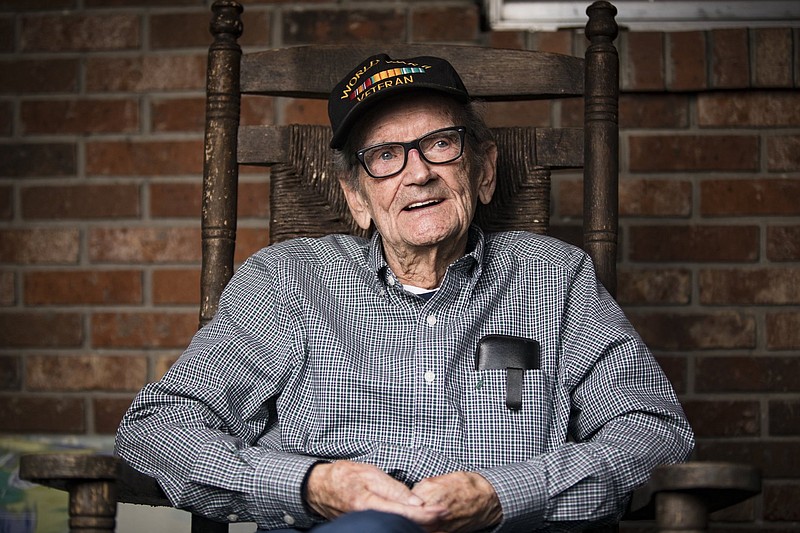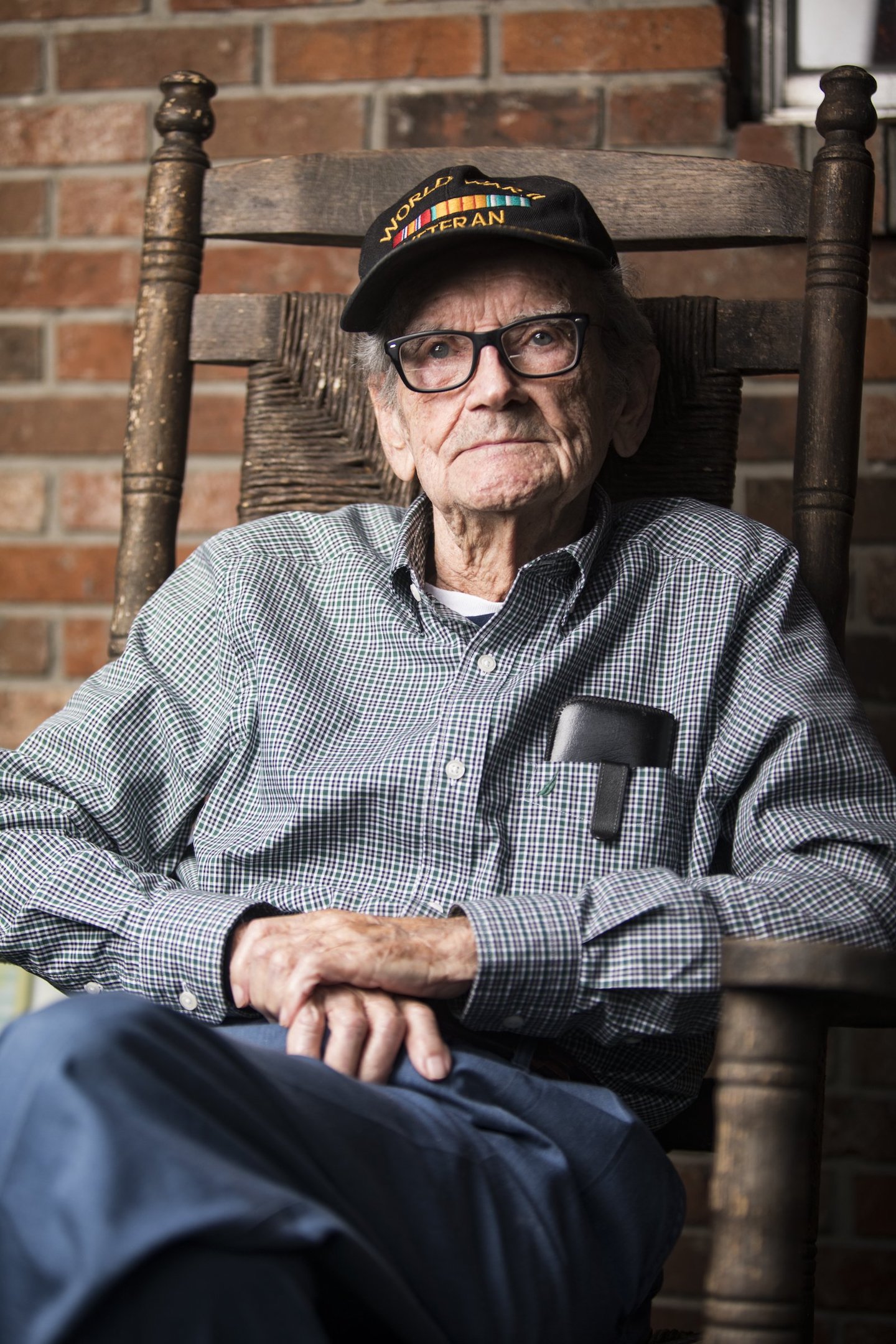Carl Morgan, 97, has become something of a celebrity at his local Costco. He's not one to brag about it, so his daughter does it for him.
"They treated him like a rock star," Kay King said of a recent visit to have her dad's hearing aid adjusted. "He had his World War II cap on, and a couple of the clerks got out their cellphones and asked to take photos with him. One of them said she'd never seen a World War II veteran before."
Because of his age and coronavirus concerns, the Rossville resident stays close to home these days. But when he does leave the house, he often wears the World War II ball cap.
"It gets me a meal every once in a while," he said, chuckling.
It has been 70 years since Morgan began his military service. It would be 50 years before he deemed his memories worth sharing.
"He never spoke of it at all" while she was growing up, his daughter said.
But after reading Tom Brokaw's "The Greatest Generation" and "The Greatest Generation Speaks," Morgan realized, "there might be some interest on the part of my grandchildren, Kelly [Nott] and Morgan [King], to know about my small part in World War II," he wrote in a brief biography.
He dismisses any notions that his service was heroic, but he saw action in a couple of storied battles and likely saved the life of a fellow sailor he correctly diagnosed with acute appendicitis.
"I still dream about [the war]," he recently told a reporter, "but it's not scary anymore."
Morgan grew up in Athens, Tennessee, where the family farm often took precedence over his schooling. At age 17, he went to live with an aunt and uncle in Chattanooga after the uncle convinced Morgan's parents that the teen would have more opportunities there.
He was a senior at Central High School when his draft notice came. A six-month deferment allowed him to graduate. He reported for duty in July 1943.
Morgan said he intended to join the Naval Reserve, but nearly wound up an Army soldier when his enlistment papers were misplaced. When he and his fellow enlistees reported to the Fort Oglethorpe Army base for physicals and induction, he was told he could ask for the original assignment from the Navy yeoman elsewhere down the line. The yeoman had room for just one more recruit, and Morgan was on his way to naval boot camp in San Diego.
BIO
Name: James Carl Morgan Age: 97 Branch: U.S. Naval Reserve Years of service: July 1943-December 1945
(Read about other local veterans in our "21-Veteran Salute" series here)
He said he considers that "the first of many lucky turns" that defined his military service.
For eight weeks of boot camp, the men took part in an intense regimen of marching, drilling, firearms, obstacle course and other training, he said. Near the end of the program, they were selected for specialized training. He believes that because he had worked part time at Turner Funeral Home his last year of high school, he was placed in the medical corps, where he received another eight weeks of training in first aid, nursing and chemical warfare. He eventually rose to the rank of pharmacist mate third class.
After stints in Texas, Louisiana and California, he was assigned to his first troop ship, the MV Day Star, and sent to Gamadodo, New Guinea. It was on that trip that he was fully initiated as a seaman - when he crossed the equator.
From the Day Star, he was assigned to the USS Hutchins, working in the sick bay. Sailors aboard the destroyer were charged with screening for submarines, escorting aircraft carriers and bombarding beaches for Marine and Army landings. During action, he said, he and the other medics would "spread out to cover the ship from stem to stern."
He was usually on the stern, or fantail, a vantage point from which he could observe planes, boats and movements of troops to shore. He was aboard the Hutchins for the Battle of Surigao Strait in the Philippines on Oct. 25, 1944.
"Not having anything to do until someone was injured allowed me plenty of time to be scared," Morgan wrote in the bio.
The Surigao Strait was one of four main engagements of the Battle of Leyte Gulf, the largest naval battle of World War II and, by some criteria, the largest naval battle in history, with more than 200,000 naval personnel involved. The Japanese Navy suffered heavy losses, enabling the successful Allied invasion of Leyte.
After that engagement, the war-battered Hutchins was sent to San Francisco for refurbishment, and Morgan was able to go home for Christmas that year for about five days, he said.
He returned to duty in the waters of Japan. He was at Iwo Jima for the Allied invasion in February 1945 and in Okinawa, the last major battle of the war, that April.
"By this time," he said, "suicide planes called kamikazes were diving on the [Allies'] ships to put them out of commission."
Rather than a plane, he said his ship took a hit from a small boat "about the size of a runabout" that emerged from hiding in a nearby cave and dropped a depth charge, usually used to destroy submarines. The detonation delivered a powerful hydraulic shock to the battleship's port side, Morgan said.
He remembers being thrown from a third-tier bunk, landing on a mattress with another seaman beneath it. Radar screens and other communications equipment went over the side into the ocean, he said.
In the chaos, as he ran to the deck, he hit his head on the barrel of a 5-inch gun that had been dislodged. "It almost knocked me out," he said.
Later, an officer, noting his injury, asked if he should submit Morgan's name for a medal. Morgan declined. "It was my own fault," he said.
The Hutchins would later dock at Pearl Harbor for temporary repairs, then was sent to Portland, Oregon, to be stripped down. Morgan bought wedding rings at a Navy store in Pearl Harbor and married Evelyn Brown, a former co-worker at the funeral home, while on leave from Portland in July 1945. (She died in 2014.)
After the war, Morgan enrolled in the University of Chattanooga, majoring in music, an interest since childhood. He had developed his playing skills during the war, joining military bands to play for dances at his duty bases and in downtime aboard ship.
Professionally, he worked 31 1/2 years as a mapmaker for the Tennessee Valley Authority, but music was a constant pastime. For many years, he served as his church choir director and played bass guitar with a Chattanooga big band, Sweet Georgia Sound.
He even published a handful of songs, including a Christmas novelty called "Sniffles (Santa's Pet)," recorded by Jimmie Davis and released by Decca in December 1967.
The bigger hit was "You Hold the Future," recorded by Tommy Sands for Capitol in 1959, with Nelson Riddle conducting the orchestra.
"It was really popular at the time," said his daughter. "He was able to buy a car from the royalties. He got a [royalty] check the other day for about $18."
Count it as proof that the "rock star" treatment at Costco doesn't have to be solely about his war service.
Email Lisa Denton at ldenton@timesfreepress.com.

